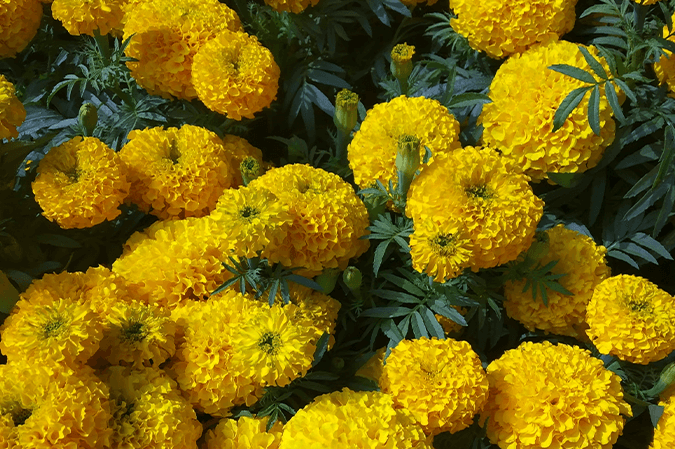Description
Marigolds are flowering plants belonging to the genus Tagetes in the family Asteraceae. They are native to the Americas but have been cultivated globally due to their vibrant colors and ease of growth. The genus Tagetes includes about 50 species, ranging from annuals to perennials. Marigolds are known for their bright yellow, orange, and red flowers, which bloom profusely throughout the growing season.
Common Features
- Leaves: Marigold leaves are typically pinnately divided, with a strong, sometimes pungent fragrance. The leaves are arranged oppositely or alternately on the stem.
- Flowers: The flowers are usually single or double and come in various shades of yellow, orange, red, and maroon. They are composed of ray florets surrounding central disc florets, typical of the Asteraceae family.
- Growth Habit: Marigolds are generally bushy, compact plants that grow from 6 inches to 3 feet in height, depending on the species and variety.
- Fragrance: Marigolds emit a distinctive aroma, which is particularly strong in the foliage. This scent is often described as spicy or musky.
Role in the Ecosystem
- Pollination: Marigolds attract a variety of pollinators, including bees, butterflies, and beetles. Their bright colors and easily accessible nectar make them a favorite in pollinator-friendly gardens.
- Pest Control: Marigolds are known for their ability to repel certain pests, such as nematodes, aphids, and mosquitoes, making them a popular companion plant in vegetable gardens. The roots and leaves release compounds that are toxic to some soil-borne pests, thus protecting neighboring plants.
- Soil Health: Marigolds can improve soil health by releasing chemicals from their roots that suppress harmful nematodes. They are often planted in crop rotation or as cover crops to enhance soil quality.
- Habitat: The dense foliage of marigolds provides cover for beneficial insects, such as ladybugs and lacewings, which prey on garden pests.
Importance
- Cultural Significance: Marigolds hold deep cultural importance in many parts of the world, particularly in India and Mexico. In India, they are used in religious ceremonies, weddings, and festivals like Diwali. In Mexico, marigolds are a key element of the Day of the Dead (Día de los Muertos) celebrations, where they are believed to guide the spirits of the deceased back to the living world.
- Medicinal Uses: Marigolds have been used in traditional medicine for their anti-inflammatory, antiseptic, and wound-healing properties. The flowers are used in herbal remedies for treating skin conditions, minor wounds, and eye infections. Marigold extract, known as calendula, is widely used in skincare products for its soothing and healing effects.
- Ornamental Value: Marigolds are one of the most popular ornamental plants, known for their bright and long-lasting blooms. They are commonly used in flower beds, borders, and container gardening. Their ability to thrive in a wide range of conditions makes them a favorite among gardeners.
- Agricultural Importance: Beyond their ornamental and cultural value, marigolds are used in agriculture to naturally deter pests and improve soil health. Their use as companion plants in vegetable gardens is widespread due to their ability to protect crops without the need for chemical pesticides.
Sources
- Royal Horticultural Society. (n.d.). Tagetes (Marigold) – Plant Finder. Retrieved from RHS
- Encyclopedia Britannica. (n.d.). Marigold | Plant, Flower, & Facts. Retrieved from Encyclopedia Britannica
- National Center for Biotechnology Information (NCBI). (n.d.). Calendula (Marigold) – Herbal Medicine Review. Retrieved from NCBI
- University of Illinois Extension. (n.d.). Marigold – Flower of the Dead. Retrieved from University of Illinois



